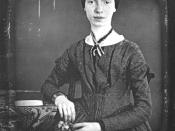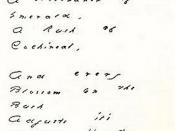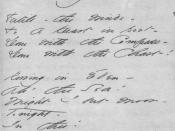Emily Dickinson's poem, "Because I could not stop for Death", features a different aspect from the deceased's life and her journey towards eternal rest. The dead is being introduced with a solemn ride of a hearse. Instead of possessing a fear of death, the deceased takes note of the polite manner in which the carriage takes it time. The slow pace displayed that the death carriage "â¦knew no haste" (l.5), and that the deceased respected his patience. From youthfulness to elderly, the stages of life are revealed. We are asked to stop and see just how short life really is. The deceased encourages the reader to take advantage of life because death is upon us. She uses the speaker to personify and welcome death as a polite and considerate gentleman, a journey "toward eternity" (l. 24).
In the first stanza, she begins her journey with a gentleman named Death who takes her along to the carriage "the carriage held but just ourselves - And Immortality" (l.
3-4). In the first line, the poet makes mention of how the speakers disappearance in the world. The life taking event, has been personified into a human form and is taking Dickinson away. As "the carriage held but just ourselves" suggest, the speaker believes that she is still alive. With the use of the term "Immortality" (l. 4) the poet shows that at the beginning of her journey the speaker is young, and enthusiastic to tell about her existence of life in the world. She cannot think of dying, she simply "could not stop for death" (l.1). In the second stanza, death escorts her so well (unhurriedly) "we slowly drove, he knew no haste" (l. 5) that it suggests pleasantness an expected peace. She rewards him by putting away her "labor"...


